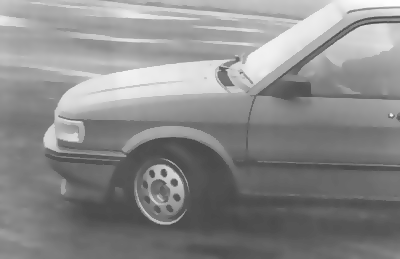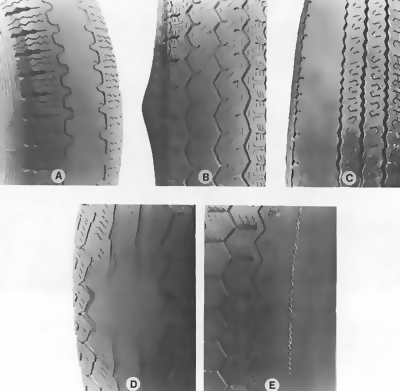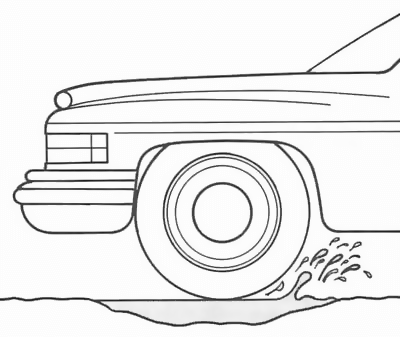Tyres
The Video Course teaches you everything about modern cars.

Considering the importance of tyres from the safety point of view, it is surprising that so many motorists seem to take them more or less for granted. Many drivers fail to check their tyres often enough for pressure , damage or wear. Although tyres have been developed by manufacturers to the point where they offer remarkable levels of grip on dry and wet roads and are extremely resistant to punctures, their qualities are compromised if they are under-inflated, badly worn or damaged. As these four footprints of tread are your only contact with the road, it is vital for everyone's safety that your tyres are in good condition.
Tyre technicalities
All new cars are equipped with radial-ply tyres, although cross-ply tyres were once usual. Apart from classic cars, a small proportion of older cars on the roads today are still running on cross-ply tyres: if yours is one of these, it would be well worth fitting radials , which offer superior roadholding and handling qualities. Remember, however, that it is illegal to mix tyres. All your tyres (including the spare) should be radials or cross-plies, although the legal requirement is not quite so inflexible. Another option is remould tyres, but these are best avoided despite their appeal from the cost point of view. Tyres are so imporant for the safety of everyone on the road that too much economy is foolish.
Most motorists replace their tyres with new ones of identical make and type. This is by far the best course, but if you decide to upgrade your tyres perhaps in the interests of better grip or longer life, check with a tyre specialist or a dealer familiar with your make of car whether this is wise. Manufacturers invariably fit the tyres most suitable for the car, so you may find that giving in to a desire to fit larger tyres (and perhaps wheels) results in unacceptably heavy steering, more road noise and an inferior ride. If the tyres are too wide they can even rub on the bodywork when the car is driven round a corner or over a bump. Grip may be better, but ask yourself whether you really need it. While economy in tyres is not to be recommended, do not allow yourself to be browbeaten by a tyre specialist into buying better tyres than your car or style of motoring require.
Do pay the extra charge to have your wheels balanced when new tyres are fitted. Out-of-balance wheels can cause vibrations which become progressively more unpleasant — and wearing for the occupants of the car — as speed increases, especially when fitted to the front wheels. It is also sensible to run-in new tyres by driving more gently for the first 100 miles or so, as the tread needs to be `scrubbed' before it will grip with maximum efficiency.
A few words about the coded markings on tyres are also worth while, as many motorists, not surprisingly, are baffled by the strings of numerals and letters used by manufacturers. A typical notation might be 165/70 SR 14. The figures refer to the size, which in this case means a tyre width of 165mm with a 'low profile' shoulder (the area between wheel rim and circumference) 70 per cent of the normal size to fit a 14-inch wheel. Quite why metric and imperial measurements are still mixed is a source of mystery. The letters refer to one of three codes denoting the maximum speed permissible on the tyre: SR tyres are for cars capable of up to 113mph, HR for 113mph-130mph and VR for over 130mph. Although these speed bands are quite academic for British motoring, you should stick with the type which the manufacturer specifies for your car.
Looking after your tyres

Careless driving can damage your car's tyres all too easily. Driving over a kerb or scraping the edge of a tyre against a kerb can cause damage which might have a disastrous result — sudden deflation — if you do not have the tyre checked. Look for splits or bulges in the tyre wall as obvious signs, but serious internal damage does not always show on the outside. As far as tyres are concerned, it is much better to be safe than sorry; have your tyres checked if you believe you might have damaged them.
Locking the wheels when braking, spinning the driving wheels under harsh acceleration and quick cornering will all wear out the tyres more quickly. Since tyres are an appreciable part of the cost you incur in running a car, it is logical to look after them properly by driving with care and keeping them at the right pressure.
Tyre pressure
Follow the manufacturer's recommended pressures (remembering that a slightly higher pressure is generally suggested for sustained motorway cruising or carrying a heavy load): do not experiment with pressures, as you are unlikely to improve on the manufacturer's findings and may well instead land yourself in trouble in an emergency. Pressure checks should be carried out at the start of a trip when the air in the tyres is cold; pressure readings are higher when the air inside a tyre has warmed up.
Recommended pressures naturally allow for this, so you will end up under-inflating your tyres if you check them when warm. Since garage pressure gauges can vary, it is a good idea, for the sake of consistency, to use a good quality pocket pressure gauge which can be bought from an accessory shop.
It is inadvisable to lower tyre pressures to cope with mud or snow; you will not necessarily have better grip, and you could damage the tyres by running them under-inflated. Should you forget what you have done, you could come a cropper on a bend because of the poor roadholding which results when the tyres squirm under cornering forces . Some motorists raise pressures to achieve a slight improvement in fuel economy, but the penalty is poorer grip, especially on wet roads.
Over-inflated and under-inflated tyres can also wear unevenly across their widths. If you notice uneven wear, make sure that the tyres have not been inflated wrongly, perhaps due to a faulty gauge. Failing this, the steering or suspension will be out of alignment, possibly because you have run over a kerb or a severe pothole. If this is the case, have the alignment corrected by a garage.
Replacing worn tyres

The law requires that tyres should be replaced when the tread depth over three-quarters of a tyre's width has worn down to its last millimetre. This is remarkably lenient as a tyre's grip will have deteriorated considerably by this point, so you would be well advised to consider replacement when the tread depth is around 3mm. A simple gauge is available to measure this accurately. Unless you have a four-wheel drive car, it is a good idea to swap your tyres between front and back wheels about halfway through their life, as tyres on the driven wheels generally wear out more quickly.
The real danger of worn tyres occurs in wet weather, for the tiny depth of tread is simply unable to cope with its task of squeezing up water from the road. For a tyre to bite down on to the road at 60mph, several gallons of water must be cleared every second; a tyre clearly does this job more efficiently the newer it is. If you are particularly sensitive to your car's handling, you will feel worn tyres offering less grip in wet weather long before the 1mm limit is reached. The first time you notice this is obviously the moment to fit one or more new tyres.
A very worn or totally bald tyre can shift so little water that it quickly rides up on to the surface, skating along on a film of water without touching the road at all. The dangers of this condition — known as aquaplaning — are self-evident: steering control, sideways grips and braking are all completely lost. Even a pefectly sound tyre can aquaplane if you drive fast over a deep puddle. If you have done this, it is quite likely that you have experienced the feeling of the steering becoming momentarily light and lifeless in your hands.
Punctures
As well as giving less grip on a wet road, worn tyres are also more susceptible to punctures. All tyres, of course, can puncture, but sudden deflation is mercifully rare these days. Many drivers neglect to carry a good spare tyre or to check its pressure along with the other four, but all eventually come to regret their haste when a puncture occurs, perhaps far from home on a wet night. Even driving just a short distance on a flat tyre can ruin it. When you suffer a puncture, have the tyre repaired (if this is possible) or replaced as soon as possible, since it is illegal and foolish to continue to drive around with a useless spare tyre.
Many motorists worry about how they would cope if they are unlucky enough to suffer a tyre blow-out when travelling quickly. It requires considerable presence of mind in the eventuality, but you should brake very gently and try to steer straight ahead — or slightly to the left if you are in danger of involving following vehicles — until you come to a stop. Even with a front wheel puncture, some steering is maintained as long as the deflated tyre is not rolled off the rim by violent movement of the wheel. Such accidents usually result from lack of attention to tyres: heavy braking or swerving after a puncture, overloading the tyres, running them in damaged condition or fitting tyres of the wrong type can all be contributory factors. Insufficient pressure causes many motorway accidents, because a tyre flexes too much, heats up and finally fails when the rubber melts and the tread peels away from the casing.
Summary
The Ultimate Car Mechanics video course
Learn everything about modern cars from our new video series.
Learn more >-
We build a Mazda MX5 Miata from scratch
We start by tearing down and then rebuilding the whole car.
-
Every part explained
There's ridiculous detail on every part. Clearly and easily explained.
-
All modeled in 3D
We've created the most detailed 3D model ever produced so we can show you everything working.






